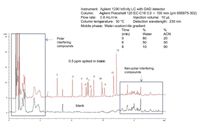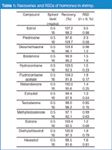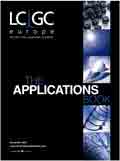Determination of Hormones in Shrimp by Agilent 1290 Infinity LC, Poroshell 120 LC Column and QuEChERS Sample Prep
Agilent Technologies Application Note
Rongjie Fu and Andy Zhai, Agilent Technologies.
Introduction
There are currently several hormones and hormone-like agents with marked ability to improve the rate of growth and efficiency of feed intake for animals. In some countries, hormones are a common food additive and controlled use of certain compounds is even considered safe. However, longterm consumption of glucocorticoids can lead to hyperglycemia, osteoporosis, birth defects and immune function decline. Other hormones such as estrogen, androgen and progesterone are carcinogenic and can lead to breast cancer, ovarian cancer and cell carcinoma. Therefore some countries strictly prohibit their application, especially the use of estrogens. A previous application note showed a new method for detecting hormones in crucian carp fish meat using an Agilent SampliQ OPT SPE cartridge for sample preparation and an Agilent ZORBAX Eclipse Plus C18 column (4.6 mm × 250 mm, 5 μm) for HPLC analysis.
Although the current QuEChERS methodology has been designed for removing matrix interferences in food products of plant origin, such as polar organic acids, sugars and lipids, it also has potential for other food matrices such as meat or seafood. Based upon the chemical properties of the compounds of interest and food matrices, some modifications of the original method might be necessary to obtain accurate and precise results. For more detail, including information on the specific hormones, see the full application note (Agilent pub no. 5990-6589EN). The purpose of this work is to extend the QuEChERS methodology to veterinary drug residues in seafood. The method was validated in terms of recovery and reproducibility.
A Poroshell 120 C18 column packed with 2.7 μm superficially porous material was used to separate 13 common hormones. The column has almost the same efficiency as sub-2 μm totally porous materials and can be used to provide a fast and high resolution analysis.
Sample Preparation
The sample preparation procedure includes sample homogenization, extraction/partitioning and dispersive SPE cleanup. An Agilent QuEChERS EN Extraction kit, p/n 5982-5650, and Agilent QuEChERS dispersive SPE kit for drug residues in meat, 15 mL, p/n 5982-4956, were used.
The shrimp was washed and chopped into small pieces, then homogenized thoroughly with a food grinder and stored at –20 °C. A 5 g (± 0.05 g) sample of homogenized shrimp was weighed in a 50 mL centrifuge tube, then centrifuged for 30 seconds to move the sample from the inside tube wall to the bottom of the tube. Samples were then fortified with appropriate QC spiking solutions when necessary. Next, 5 mL of water was added. Tubes were then vortexed for 10 s to mix. A 10 mL volume of ACN was added to each tube. Tubes were capped and shaken by hand for 30 s. An Agilent QuEChERS EN extraction salt packet (p/n 5982-5650) was added to each tube. Sample tubes were capped tightly and shaken vigorously for 1 min. Tubes were centrifuged at 4000 rpm for 5 min at 4 °C.
A 6 mL aliquot of the upper ACN layer was transferred into an Agilent QuEChERS dispersive SPE 15 mL tube for drug residues in meat (p/n 5982-4656). This 15 mL dispersive SPE tube contained 150 mg of C18 and 900 mg of anhydrous MgSO4. The tubes were tightly capped and vortexed for 1 min. The 15 mL tubes were centrifuged at 13000 rpm for 3 min at 4 °C. A 4 mL volume of extract was transferred into another tube and dried by N2 flow at 35 °C. Samples were reconstituted into 2 mL of 1:4 ACN/H2O. After vortexing and sonicating for 10 min, the sample was filtered through a 0.22 um Cellulose Acetate Spin Filter (p/n 5185-5990). The clear, filtered sample was transferred into an autosampler vial. The samples were capped and vortexed thoroughly in preparation for HPLC analysis.
Results and Discussion
All 13 compounds were well separated in 8 minutes in a 20% ACN solution. Each compound was present at a 1 ppm level and excellent sensitivity was achieved. Figure 1 shows the chromatograms of blank sample and 0.5 ppm spiked into the blank sample. To study the system suitability for the shrimp sample, the hormone mixture was spiked into the blank sample after the QuEChERS extraction method was adjusted so that the target compounds were separated from the matrix. The analysis time was extended to 10 min to allow matrix and nonrelevant sample components to be eluted.

Figure 1: Chromatograms of blank sample and 0.5 ppm spiked in blank sample.
This short analysis time is noteworthy for this complex sample, and is possible through the combined power of the Agilent 1290 Infinity LC and the Poroshell 120 column.
Recovery and Repeatability
The precision of the method was determined in terms of the recovery of spiked hormone standards in homogenized shrimp at 0.5, and 10 mg/kg. The analysis was repeated six times for each level. The data in Table 1 demonstrate excellent recovery and reproducibility for the QuEChERS method developed for hormone determination in shrimp.

Table 1: Recoveries and RSDs of hormones in shrimp.
Conclusions
The Agilent QuEChERS Buffered Extraction EN kit and the Agilent dispersive SPE kit for drug residues in meat provide a simple, fast and effective method for the purification of hormones in shrimp. Compared to other sample pretreatment methods, such as LLE and SPE, the QuEChERS method is easier to handle, faster, labour saving and less expensive. The recovery and reproducibility, based on matrix spiked standards, were acceptable for multiresidue hormone determination in shrimp. The Agilent 1290 Infinity LC and the Agilent Poroshell 120 column resolved the 13 compounds in 10 min and all the compounds were well-separated from the matrix. The method developed is suitable for the determination of hormones in shrimp at low mg/kg levels.
For More Informaton: Search for the full-length application note at www.chem.agilent.com (publication # 5990-6589EN)

Agilent Technologies Inc.
2850 Centerville Road, Wilmington, Delaware 19808, USA
tel. +1 800 227 9770 fax +1 302 633 8901
Website: www.agilent.com

New Study Reviews Chromatography Methods for Flavonoid Analysis
April 21st 2025Flavonoids are widely used metabolites that carry out various functions in different industries, such as food and cosmetics. Detecting, separating, and quantifying them in fruit species can be a complicated process.
Analytical Challenges in Measuring Migration from Food Contact Materials
November 2nd 2015Food contact materials contain low molecular weight additives and processing aids which can migrate into foods leading to trace levels of contamination. Food safety is ensured through regulations, comprising compositional controls and migration limits, which present a significant analytical challenge to the food industry to ensure compliance and demonstrate due diligence. Of the various analytical approaches, LC-MS/MS has proved to be an essential tool in monitoring migration of target compounds into foods, and more sophisticated approaches such as LC-high resolution MS (Orbitrap) are being increasingly used for untargeted analysis to monitor non-intentionally added substances. This podcast will provide an overview to this area, illustrated with various applications showing current approaches being employed.

.png&w=3840&q=75)

.png&w=3840&q=75)



.png&w=3840&q=75)



.png&w=3840&q=75)












